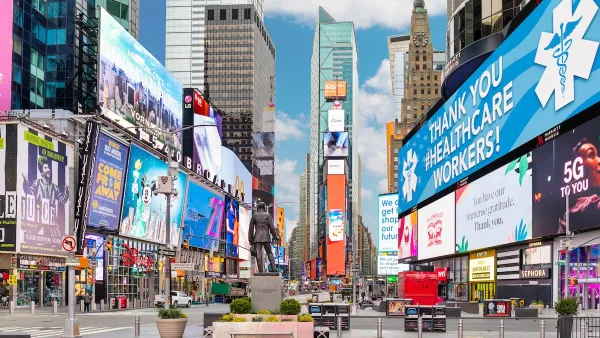Nicole Gelinas reports on the effects of Mayor Michael Bloomberg’s controversial 2009 transportation reforms, which have unexpectedly lightened the traffic and dangers on New York’s streets.
Gelinas looks at what was unveiled as a "targeted adjustment" to pedestrianize segments of Broadway in Midtown Manhattan, but what some understood at the time, and has become clear since, was a revolutionary "shift away from a century's worth of New York transportation policy." In 2009, New Yorkers were concerned that the "adjustment" would only increase the traffic on nearby streets, but the conversion from car-filled avenue to "pedestrian plaza" has actually increased the flow of traffic and reduced traffic-related fatalities.
Gelinas looks at the successes of the improvements to Broadway, and beyond, as "New York has been rationally using its limited physical space to get more people moving more quickly-and that means not in automobiles. New York has achieved its improvements on the cheap. Better still, the changes have saved lives."
With New York facing the challenges of overflowing subways, clogged bus systems, and reckless cyclists, Gelinas argues that Mayor Bloomberg's transportation oriented plans are a step in the right direction towards creating a safer, speedier, and sustainable New York.
Thanks to Akemi Lueng
FULL STORY: Ungridlocked

National Parks Layoffs Will Cause Communities to Lose Billions
Thousands of essential park workers were laid off this week, just before the busy spring break season.

Retro-silient?: America’s First “Eco-burb,” The Woodlands Turns 50
A master-planned community north of Houston offers lessons on green infrastructure and resilient design, but falls short of its founder’s lofty affordability and walkability goals.

Delivering for America Plan Will Downgrade Mail Service in at Least 49.5 Percent of Zip Codes
Republican and Democrat lawmakers criticize the plan for its disproportionate negative impact on rural communities.

Test News Post 1
This is a summary

Test News Headline 46
Test for the image on the front page.

Balancing Bombs and Butterflies: How the National Guard Protects a Rare Species
The National Guard at Fort Indiantown Gap uses GIS technology and land management strategies to balance military training with conservation efforts, ensuring the survival of the rare eastern regal fritillary butterfly.
Urban Design for Planners 1: Software Tools
This six-course series explores essential urban design concepts using open source software and equips planners with the tools they need to participate fully in the urban design process.
Planning for Universal Design
Learn the tools for implementing Universal Design in planning regulations.
EMC Planning Group, Inc.
Planetizen
Planetizen
Mpact (formerly Rail~Volution)
Great Falls Development Authority, Inc.
HUDs Office of Policy Development and Research
NYU Wagner Graduate School of Public Service




























